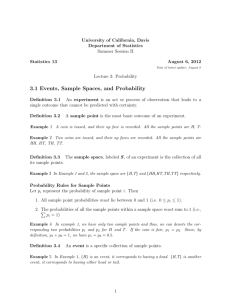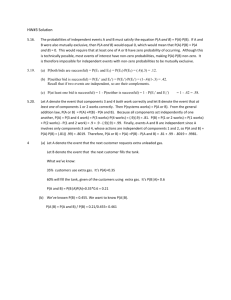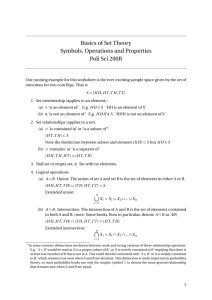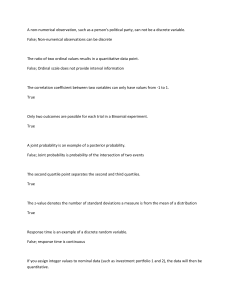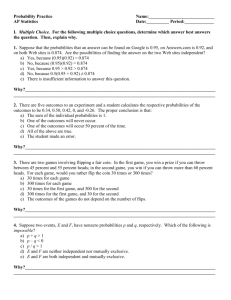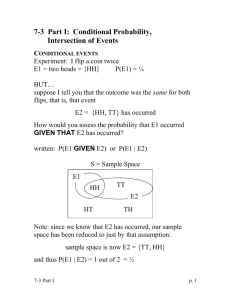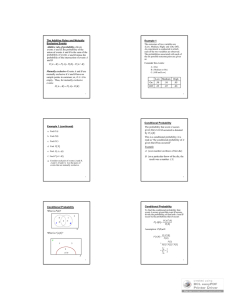Statistics 13 Elementary Statistics
advertisement
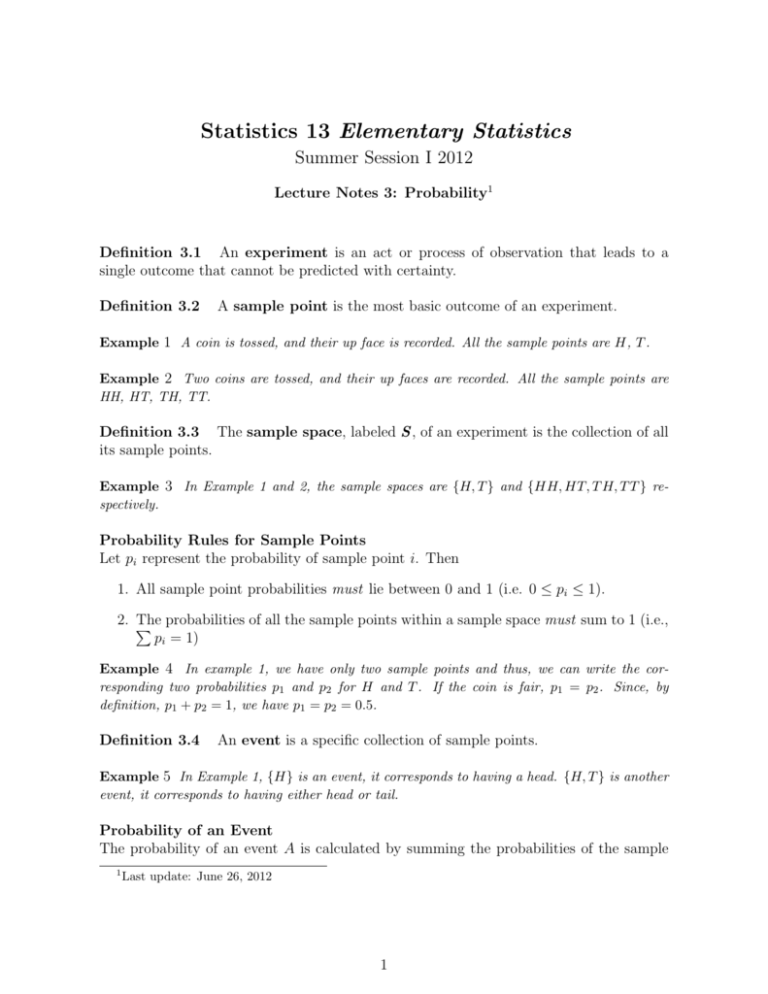
Statistics 13 Elementary Statistics
Summer Session I 2012
Lecture Notes 3: Probability1
Definition 3.1 An experiment is an act or process of observation that leads to a
single outcome that cannot be predicted with certainty.
Definition 3.2
A sample point is the most basic outcome of an experiment.
Example 1 A coin is tossed, and their up face is recorded. All the sample points are H, T .
Example 2 Two coins are tossed, and their up faces are recorded. All the sample points are
HH, HT, TH, TT.
Definition 3.3 The sample space, labeled S , of an experiment is the collection of all
its sample points.
Example 3 In Example 1 and 2, the sample spaces are {H, T } and {HH, HT, T H, T T } respectively.
Probability Rules for Sample Points
Let pi represent the probability of sample point i. Then
1. All sample point probabilities must lie between 0 and 1 (i.e. 0 ≤ pi ≤ 1).
2. P
The probabilities of all the sample points within a sample space must sum to 1 (i.e.,
pi = 1)
Example 4 In example 1, we have only two sample points and thus, we can write the corresponding two probabilities p1 and p2 for H and T . If the coin is fair, p1 = p2 . Since, by
definition, p1 + p2 = 1, we have p1 = p2 = 0.5.
Definition 3.4
An event is a specific collection of sample points.
Example 5 In Example 1, {H} is an event, it corresponds to having a head. {H, T } is another
event, it corresponds to having either head or tail.
Probability of an Event
The probability of an event A is calculated by summing the probabilities of the sample
1
Last update: June 26, 2012
1
points in the sample space for A.
Example 6 Refer to Example 4 and 5. If A = {H}, P (A) = p1 = 0.5. If A = {H, T },
P (A) = p1 + p2 = 1.
Steps for Calculating Probabilities of Events
1. Define the experiment; that is, describe the process used to make an observation
and the type of observation that will be recorded.
2. List the sample points.
3. Assign probabilities to the sample points.
4. Determine the collection of sample points contained in the event of interest.
5. Sum the sample point probabilities to get the probability of the event.
Counting the number of sample points in a sample space can help us to assign the probability. A method of determining the number of sample points for an experiment is to use
combinatorial mathematics.
Permutations Rule
An ordered arrangement of k objects taken from a set of n objects (1 ≤ k ≤ n) is a
permutation:
Prn = n(n − 1) · · · (n − r + 1)
Combinations Rule
An unordered arrangement of k objects taken from a set of n objects is a combination:
n
n!
n
Cr =
=
r
r!(n − r)!
where
n! = n(n − 1)(n − 2) · · · (3)(2)(1)
and similarly for r! and (n − r)!. For example, 5! = 5 · 4 · 3 · 2 · 1. Note: 0! is defined to
be equal to 1.
3.2 Unions and Intersections
Definition 3.5 The union of two events A and B is the event that occurs if either A
or B (or both) occurs on a single performance of the experiment. We denote the union of
events A and B by the symbol A ∪ B. A ∪ B consists of all the sample points that belong
to A or B or both.
2
Definition 3.6 The intersection of two events A and B is the event that occurs if
both A and B occur on a single performance of the experiment. We write A ∩ B for the
intersection of A and B. A ∩ B consists of all the sample points belonging to both A and
B.
3.3 Complementary Events
Definition 3.7 The complement of an event A is the event that A does not occur that is, the event consisting of all sample points that are not in event A. We denote the
complement of A by Ac .
Rule of Complements
The sum of the probabilities of complementary events equals 1; that is
P (A) + P (Ac ) = 1
Example 7 Let #A denote the number of sample points in the event A (with a similar definition
for #B, #(A ∪ B), etc).
Given that #(A ∪ B) = 20, #(A) = 12, #(B) = 9 find:
(a) #(A ∩ B)
(b) #(A ∩ B c )
(c) #(B ∩ Ac )
3.4 The Additive Rule and Mutually Exclusive Events
Additive Rule of Probability
The probability of the union of events A and B is the sum of the probability of event A
and the probability of event B, minus the probability of the intersection of event A and
B; that is
P (A ∪ B) = P (A) + P (B) − P (A ∩ B)
Definition 3.8 Events A and B are mutually exclusive if A ∩ B contains no sample
points - that is if A and B have no sample points in common. For mutually exclusive
events,
P (A ∩ B) = 0
3
Probability of Union of Two Mutually Exclusive Events
If two events A and B mutually exclusive, the probability of the union of A and B equals
the sum of the probability of A and the probability of B; that is, P (A∪B) = P (A)+P (B).
3.5 Conditional Probability
If we have additional knowledge that might effect the outcome of an experiment, so we
may need to alter the probability of an event of interest. A probability that reflects such
additional knowledge is called the conditional probability of the event.
Conditional Probability Formula
To find the conditional probability that event A occurs given that event B occurs, divide
the probability that both A and B occur by the probability that B occurs; that is,
P (A|B) =
P (A∩B)
P (B)
where we assume that P (B) 6= 0
3.6 The Multiplicative Rule and Independent Events
Multiplicative Rule of Probability
P (A ∩ B) = P (A)P (B|A) or, equivalently, P (A ∩ B) = P (B)P (A|B)
Definition 3.9 A partition is a collection of mutually exclusive sets (events) that together form the sample space.
Law of total probability
The law of total probability states that given a partition {A1 , A2 , . . . , Ak } of the event
space,
k
X
P (B) =
P (B|Ai )P (Ai )
i=1
Definition 3.10 Events A and B are independent events if the occurrence of B does
not alter the probability that A has occurred; that is, event A and B are independent if
4
P (A|B) = P (A)
When events A and B are independent, it is also true that
P (B|A) = P (B)
Events that are not independent are said to be dependent.
Probability of Intersection of Two Independent Events
If events A and B are independent, then the probability of the intersection of A and B
equals the product of the probabilities of A and B; that is
P (A ∩ B) = P (A)P (B)
The converse is also true: If P (A∩B) = P (A)P (B), then events A and B are independent.
Example 8 If P (A) = 0.4, P (B) = 0.5 and P (A ∪ B) = 0.8 then what is P (A ∩ B)? Are A
and B independent?
5
